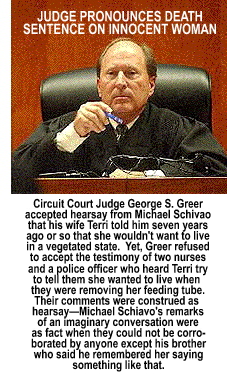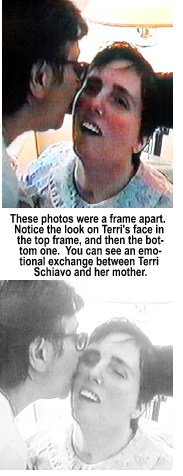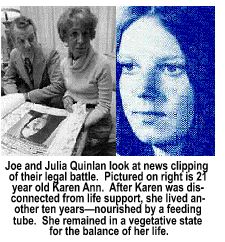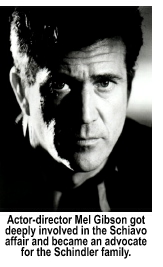
News
Behind the Headlines
Two-Cents Worth
Video of the Week
News Blurbs
Articles
Testimony
Bible Questions
Internet Articles (2015)
Internet Articles (2014)
Internet
Articles (2013)
Internet Articles (2012)
Internet Articles (2011)
Internet Articles (2010)
Internet Articles
(2009)
Internet Articles (2008)
Internet Articles (2007)
Internet Articles (2006)
Internet Articles (2005)
Internet Articles (2004)
Internet Articles (2003)
Internet Articles (2002)
Internet Articles (2001)


 erri
Schindler Schiavo is dead. She
officially died at 9:05 a.m. on Thursday, March 31, 2005. But her death
really took place on March 18, 2005 even though she had not yet stopped
breathing. On that date, Terri Schiavo began her valiant, desperate,
futile battle for life. On March 18, 2005 doctors at Woodside Hospice
in Pinellas Park, Florida removed the feeding tube from the brain-damaged
woman and initiated the death sentence imposed upon her by Pinellas
County Circuit Court Judge George S. Greer
erri
Schindler Schiavo is dead. She
officially died at 9:05 a.m. on Thursday, March 31, 2005. But her death
really took place on March 18, 2005 even though she had not yet stopped
breathing. On that date, Terri Schiavo began her valiant, desperate,
futile battle for life. On March 18, 2005 doctors at Woodside Hospice
in Pinellas Park, Florida removed the feeding tube from the brain-damaged
woman and initiated the death sentence imposed upon her by Pinellas
County Circuit Court Judge George S. Greer  at
the request of Michael Schiavo, her estranged husband and legal
guardian—death by dehydration. To guarantee her death, Judge Greer
exceeded his moral authority as a magistrate and ordered that Terri
Schiavo could have no food or water—not even by traditional means.
In doing so, he sentenced her to suffer a death so horrific that no
judge could have imposed such a sentence on a killer and not have the
sentence overturned.Yet, no other court in this land raised a finger
to to overturn his unconscionable decision. The 7-year legal battle between
Bob and Mary Schindler and Michael Schiavo became
the longest, most acrimonious court battle over a right-to-die case in
the history of the United States. At one point or another, approximately
40 judges in six State and federal courts became entangled in this case
as Terri Schiavo's life ebbed from her frail body. So did 535 members
of Congress, one governor and one president. Yet, in the end, the death
sentence imposed on an innocent woman by one local judge prevailed.
at
the request of Michael Schiavo, her estranged husband and legal
guardian—death by dehydration. To guarantee her death, Judge Greer
exceeded his moral authority as a magistrate and ordered that Terri
Schiavo could have no food or water—not even by traditional means.
In doing so, he sentenced her to suffer a death so horrific that no
judge could have imposed such a sentence on a killer and not have the
sentence overturned.Yet, no other court in this land raised a finger
to to overturn his unconscionable decision. The 7-year legal battle between
Bob and Mary Schindler and Michael Schiavo became
the longest, most acrimonious court battle over a right-to-die case in
the history of the United States. At one point or another, approximately
40 judges in six State and federal courts became entangled in this case
as Terri Schiavo's life ebbed from her frail body. So did 535 members
of Congress, one governor and one president. Yet, in the end, the death
sentence imposed on an innocent woman by one local judge prevailed.
At no time ever in the past
in the history of this nation has a magistrate, in removing a terminal
patient from life support, denied that patient the right to consume nutrients
by traditional means. Pinellas County Circuit Court Judge George S.
Greer exceeded his moral authority by ordering that not only could Terri Schiavo not have nutrients by feeding tube, but that she
was not allowed to ingest liquids by mouth, either. That was tantamount
to a death sentence—not of a human vegetable, but of a human being
capable of experiencing emotion...and pain.  Nevertheless,
a woman who had committed no crime was sentenced to suffer such a death—and
the higher courts that should have become her arbitrators, turned their
backs on her as well. Terri Schiavo suffered for 13 days before
she went into renal failure and the toxins in her blood poisoned her.
Because the pain from that type of death is horrific, she was finally
placed on a morphine drip that slowed her respiration and aided in ending
her life. As she transitioned from life to death, Michael Schiavo and his lawyer,
Nevertheless,
a woman who had committed no crime was sentenced to suffer such a death—and
the higher courts that should have become her arbitrators, turned their
backs on her as well. Terri Schiavo suffered for 13 days before
she went into renal failure and the toxins in her blood poisoned her.
Because the pain from that type of death is horrific, she was finally
placed on a morphine drip that slowed her respiration and aided in ending
her life. As she transitioned from life to death, Michael Schiavo and his lawyer,.jpg) George Felos assured the spectators outside of Woodside
Hospice, and the media, that she was resting peacefully and that
she was experiencing no pain.
George Felos assured the spectators outside of Woodside
Hospice, and the media, that she was resting peacefully and that
she was experiencing no pain.
I was not at all surprised that Judge Greer was expelled from his church. Nor was I surprised that Greer was flooded with a virtual sea of of death threats, angry emails, faxes, phone calls and criticism from constitutional groups, disability rights groups, pro-life groups—and even Jesse Jackson. (Well, actually Jesse Jackson's showing up did surprise me although with all of the news cameras at Woodside, Jackson, or someone like him, was bound to show up for the photo op.) The real tragedy of the Terri Schiavo story is that the daughter of Bob and Mary Schindler was not a terminally ill patient. She was not "brain dead." Granted, she was never going to walk out of Woodside Hospice regardless how much physical therapy she received. Terri Schiavo was a bulimic oxygen-deprived woman who suffered severe brain damage after a fall in her home. Her crime—the crime for which she was sentenced to death—was that she was so severely infirm and so mentally incapacitated that she would never again be a functional member of society. Nevertheless, according to at least one medical doctor who examined her, with rehabilitation and speech therapy, Terri Schiavo could have become a communicative, functional member of the Schindler family. But that would have posed a serious dilemma for Michael Schiavo who had moved on with his life and replaced her with a common law wife and two children born from that union. Terri Schiavo was just so much extra baggage that no longer fit in the world he created.
Tragically, as the end drew
near, and as the medical staff at Woodside gave the dehydrated
woman scant hours to live, Michael Schiavo, who reportedly once
said to his semi-comatose wife, "Why won't you die, bitch?" again showed his selfish contempt  for
the Schindler family by refusing to allow either his wife's parents
or his brother- or sister-in-law into her room to say good-bye to Terri in those last moments as she was passing from this life to the next. The
13-day Schiavo death watch was divisive because a moral nation
knew that an immoral judge had taken it upon himself to play God by denying
a living person the right to basic nutrition—even by swallowing fluids
through traditional means.
for
the Schindler family by refusing to allow either his wife's parents
or his brother- or sister-in-law into her room to say good-bye to Terri in those last moments as she was passing from this life to the next. The
13-day Schiavo death watch was divisive because a moral nation
knew that an immoral judge had taken it upon himself to play God by denying
a living person the right to basic nutrition—even by swallowing fluids
through traditional means.
In the past, judges have
removed vegetative patients from life support. Judges now have that authority
through a myriad of right-to-die laws enacted between 1990-1994. However,
any  patient
who was able to survive without life support were not deprived of food
and water. Probably the best known example of this was Karen Ann Quinlan.
patient
who was able to survive without life support were not deprived of food
and water. Probably the best known example of this was Karen Ann Quinlan.
At around 2 a.m. on April 15, 1975 Quinlan's adoptive parents, Joe and Julia Quinlan received a call from Newton Memorial Hospital that their 21-year old daughter, Karen Ann was brought in. She was in a coma from a night of drinking vodka—after taking Valium. When doctors determined Karen Ann's condition was irreversible, she was transferred to St. Clare's Hospital in Denville nine days later. After consulting with their parish priest the Quinlan's decided Karen Ann would never want to be kept alive by artificial means. Her parents signed a consent form authorizing the hospital to remove Karen Ann from her respirator. Ultimately the hospital refused their request and Quinlan v St. Clare's Hospital became the most watched right-to-die case in the nation until the Schiavo case. While he lost in Superior Court, Joe Quinlan successfully argued to the New Jersey Supreme Court that his adopted daughter would not want to live as a vegetable and should be allowed to die with dignity.
.jpg) Quinlan was appointed Karen Ann's legal guardian with power-of-attorney
to act in her name. That decision allowed him to take his daughter off
of life support. From Quinlan v St. Clare's Hospital came the Living
Will that empowers people to decide whether or not extraneous efforts
should be taken to sustain their lives should they suffer from a catastrophic,
debilitating illness or injury. Only, Karen Ann did not die. She
lived until June 11, 1985, dying from pneumonia. Karen Ann spent
her last years in a hospice named after her, founded by her mother.
Quinlan was appointed Karen Ann's legal guardian with power-of-attorney
to act in her name. That decision allowed him to take his daughter off
of life support. From Quinlan v St. Clare's Hospital came the Living
Will that empowers people to decide whether or not extraneous efforts
should be taken to sustain their lives should they suffer from a catastrophic,
debilitating illness or injury. Only, Karen Ann did not die. She
lived until June 11, 1985, dying from pneumonia. Karen Ann spent
her last years in a hospice named after her, founded by her mother.
Today, however, it does not matter if you have a Living Will or not. Hospital officials in every city in the nation urge the family members to "no code" elderly relatives who are being admitted into the nation's medical care facilities—even if they are diagnosed with non-terminal chronic illnesses. "No code"denies any form of medical intervention to the patient in the event of an emergency situation like cardiac arrest or some other form of respiratory failure. It is the essential first step in euthanizing a terminal patient. Increasingly, it is used to quietly dispatch chronically-ill patients whose quality of life cannot improve and who have become a financial drain on the Medicare system and on their families.
Mary Therese Helmueller, an RN from Minneapolis authored an article in the Catholic magazine, Homiletic, in 1998. In the article she noted that while she was visiting in Mexico City in February of that year, her grandmother was admitted to a local hospital with a fracture above her left knee. According to the hospital records she personally examined upon her return, her grandmother was alert and oriented upon admission. But, the report added, she became unresponsive after 48 hours, went into a coma. She was transferred to a hospice two days later. Carefully tracing the events that led up to her grandmother's coma, Helmueller discovered that her grandmother became unresponsive after each pain medication.
She was diagnosed as having a stroke and being in renal failure. Helmueller's grandmother died shortly after her arrival at the hospice. The hospital charts were normal. The CATscan was negative for stroke or obstruction. The EEG indicated no seizure activity. All the blood work was normal. She was not in renal failure. The only anomaly Helmueller found was the overmedication of her grandmother. She also noticed her grandmother was listed as a "No Code" patient.
Helmueller insists her grandmother had no terminal illnesses. Nevertheless, the hospice's admitting records reveal that two doctors stated that she was terminally ill and would die within six months. The first doctor, the director of the hospice, never examined or evaluated her. Nor did he even read her chart. The second doctor was on vacation when she was admitted. He did not return until three days after her death. Yet, in their expert medical opinion, she was terminal when she arrived at the hospice. (Hospices, for those who don't know, are transitional care facilities. Those who are suffering either from terminal illnesses or progressive debilitating chronic illnesses are usually transferred to TC facilities which are generally referred to as "exit treatment" facilities—referring to an exit from life. Hospice patients usually arrive by ambulance and leave by hearse.)
No one better understood what was going on at the Woodside Hospice in Pinellas Park, Florida than the pro-life disability rights groups like Not Dead Yet that showed up to stand, in solidarity, with Terri Schiavo and the Schindler family during Terri's deathwatch. Like thre rest of America, they have been watching the alarming growth of medical euthanasia over the past decade, and they find it troublesome that our courts are legalizing euthanasia by judicial fiat. While the catastrophic impaired—particularly when they are aged and infirmed—now have a court-protected right to die— with or without a Living Will, they no longer possess an unquestionable right to live. Not Dead Yet recently asked Congress to pass a law requiring federal courts to review all cases where the end-of-life wishes of the impaired person are not in writing and where family members disagree on end-of-life decisions.
Even if such a law were written, the courts can be expected to weigh in favor of those family members opting for euthanasia. The federal government is increasingly faced with a catastrophic dilemma as America grays. Too many people living too long is now creating an unfathomable burden on the U.S. Treasury that the US government —and the taxpayers—cannot afford.
The American Court system
is increasingly embracing the argument that beneficence prevents unnecessary
suffering for the individual and saves the family—or the State—from
bearing what could become a crushing financial obligation if the patient
lingers too long. Beneficence—a selfless act designed to spare the
loved ones of the patient from both physical and financial anguish—right-to-die
advocates argue, justifies euthanasia.  Even
with the best palliative care there will always be patients for whom there
will be no relief from suffering since there are no pain killers strong
enough to dull the pain they endure daily. Right-to-die advocates maintain
that since many of these people can't even find temporary relief from
the intractable pain that is an inescapable part of their lives, terminally
ill or chronically ill patients should have an option that will allow
them to escape the pain and misery that blankets their minds like a death
shroud and makes them wonder, from day-to-day or hour-to-hour, what is
the point of their continued existence.
Even
with the best palliative care there will always be patients for whom there
will be no relief from suffering since there are no pain killers strong
enough to dull the pain they endure daily. Right-to-die advocates maintain
that since many of these people can't even find temporary relief from
the intractable pain that is an inescapable part of their lives, terminally
ill or chronically ill patients should have an option that will allow
them to escape the pain and misery that blankets their minds like a death
shroud and makes them wonder, from day-to-day or hour-to-hour, what is
the point of their continued existence.
While euthanasia may rightly be construed as an act of mercy for a handful of people in a handful of instances nationwide, the American people need to very carefully consider what they wish for when they demand the passage of "right-to-die" legislation since the Living Will does not give those signing them more control over their fate. It provides legal cover for its beneficiary—the medical care facility—who has been given the power to take your life. The Living Will does not promote well-being—except perhaps for the "well-being" of the coffers of the government. Medicare, which foots the bill for medical care for the aged, is facing the same types of shortfalls as Social Security—a rapidly shrinking tax base as more and more members of grey America becomes eligible for benefits. The question lurking in the back of the mind of government is: at what point can Uncle Sam no longer afford to care for chronically ill patients? At what point does voluntary euthanasia, requested through a Living Will, become mandatory euthanasia?
If we accept the logic that it is morally defensible to demand that we be allowed to die to alleviate our own needless suffering from a chronic or terminal illness or injury that will ultimately result in our dying, then how can we reject the notion that government is not morally justified in establishing a mandatory criteria for doctors to follow in cases where patients are construed to be terminal? Or, where elderly patients are admitted with chronic medical problems that simply drain the system without any hope of the patient's health improving?
The moral argument is a two-headed dragon. You can't argue for the right of people to be allowed to end their own lives by rejecting extraneous measures to keep them alive and, in the same breath, reject the right of government to arbitrarily decide to end lives judged to be not worth living, or which are too much of a drain on the healthcare system to pay for the care needed to assure your survival..
That is the dilemma facing America. That is why America became so divided watching the life or death struggle of Terri Schindler-Schiavo. Looming heavily in the minds of those who believed custodial rights for Terri Schiavo should have been granted to her parents was the frightening question of how a local Pinellas County judge could presume to sentence to death an innocent woman on a hearsay statement from her estranged husband who wanted her dead so he could marry his common law wife.
 Hollywood
actor-director Mel Gibson, who had been in constant contact with
the Schindler family through most of the 13-day ordeal, told Sean
Hannity on Fox News that what was happening in Pinellas
Park, Florida was a modern-day crucifixion with a pro-death agenda driving
it. "It's just completely wrong to deprive this poor woman of
food and water," he said. "It's a prolonged and cruel
execution. What happened to just being a human being, you know? It's nothing
more than State-sanctioned murder. All the big guys—they all have
their hands tied up by some tinhorn judge down there. Come on. When they
want to whip a judge, they got no problem doing it. Look what they did
to [Judge] Roy Moore. So they can do it if they want. They just
didn't want to. It's a precedent that they set. We may be able to save
a few Social Security dollars later on down the track simply by pulling
the plug on the infirmed, or the disabled, or the aged. It's the inevitability
of gradualism. There is an agenda, and people say, 'Well, they can't all
be in it together,' but there's no other way to explain this behavior."
Hollywood
actor-director Mel Gibson, who had been in constant contact with
the Schindler family through most of the 13-day ordeal, told Sean
Hannity on Fox News that what was happening in Pinellas
Park, Florida was a modern-day crucifixion with a pro-death agenda driving
it. "It's just completely wrong to deprive this poor woman of
food and water," he said. "It's a prolonged and cruel
execution. What happened to just being a human being, you know? It's nothing
more than State-sanctioned murder. All the big guys—they all have
their hands tied up by some tinhorn judge down there. Come on. When they
want to whip a judge, they got no problem doing it. Look what they did
to [Judge] Roy Moore. So they can do it if they want. They just
didn't want to. It's a precedent that they set. We may be able to save
a few Social Security dollars later on down the track simply by pulling
the plug on the infirmed, or the disabled, or the aged. It's the inevitability
of gradualism. There is an agenda, and people say, 'Well, they can't all
be in it together,' but there's no other way to explain this behavior."
House Majority Leader Tom
DeLay [R-TX] condemned not only Greer, but the federal judiciary
which turned a deaf ear on the pleas of the Schindlers to intercede—if
only to make certain [a] that it actually was Terri Schiavo's
will and not Jodi Centonza's that she die (since she did not leave
a living will); and [b] in removing her feeding tube based on Michael
Schiavo's contention to Judge Greer that she was a vegetable
who could not swallow, that she be allowed to have nourishment if she
could swallow it on her own. Instead, Greer ruled that not only
were the feeding tubes to be removed, no one was allowed to give her water
or nourishment. .jpg) Heavy-handedly, Greer sentenced her to death for the crime of being mentally-impaired.
Even if she could swallow on her own, he denied her sustenance.
Heavy-handedly, Greer sentenced her to death for the crime of being mentally-impaired.
Even if she could swallow on her own, he denied her sustenance.
Delay warned the State and federal judges that Congress ''...will look at an arrogant and out-of-control judiciary that thumbs its nose at Congress and the president.'' Delay added that he "...never thought [he'd] see the day when a US judge stopped feeding a living American so that they took 14 days to die.''
After the Schiavo incident was televised almost nonstop for 13 days on satellite TV, the Euthanasia Society distributed over 60 thousand living wills. The
only one I know of that amended a Living Will to protect her from premature
euthanasia was Michael Schiavo's common law wife, Jodi Centonze—who
suffers from nacrolepsy. Centonze amended her own Living Will to
include a precaution about euthanizing her during a deathlike nacroleptic
trance that resembles an irreversible coma. "I love Michael," Centonze told the media, "and if/when we are married, I
want a clear and  lucid
stipulation between a 'vegetative state' and 'really, really tired.'" Centonze has made every effort to get her narcolepsy "on the
record" so that, in the event she dropped into a narcoleptic sleep
her husband would not be able to "litigate" her slumber. Knowing Schiavo's penchant for discarding infirmed spouses, I guess she
doesn't want to be the next Fox News euthanasia special.
lucid
stipulation between a 'vegetative state' and 'really, really tired.'" Centonze has made every effort to get her narcolepsy "on the
record" so that, in the event she dropped into a narcoleptic sleep
her husband would not be able to "litigate" her slumber. Knowing Schiavo's penchant for discarding infirmed spouses, I guess she
doesn't want to be the next Fox News euthanasia special.
When the Netherlands enacted an euthanasia law on November 28, 2000, Pope John Paul condemned the law which violated the Geneva Accord of 1948. A Vatican spokesman said, "Again we find ourselves face to face with a state law that violates natural law and individual conscience...[that is] a grave problem of professional ethics for the doctors who must put it into practice." Under the Dutch law, patients are able to make a written request for euthanasia, giving their doctors the right to use their own discretion when patients become too physically or mentally ill to make rational decisions on their own. Last year in the Netherlands there were over 2,500 physician assisted suicides. How many of them, I wonder, actually wanted to go through with it at the time their doctor arbitrarily acted upon their request? In one case a man—a Catholic—who had been estranged from his family for quite some time developed terminal cancer. His doctor estimated he would die within a year or so. Knowing the pain he was going to face down the road, he signed a consent form. Shortly thereafter, he reconciled with his family. As the family reunification progressed, he began experiencing some new pain that was not alleviated by his current pain medication. His wife called the nurse who, in turn, relayed the wife's message to the doctor. Instead of asking the patient to go to his office, the doctor went to his home. The physician gave his patient an injection. The patient gasped and died. The wife screamed that she had not asked the doctor to kill her husband—who had not yet reconciled with God. Neither she nor her husband realized that the release he signed trumped his current desires. He gave his doctor the right to determine when he should die and the doctor exercised that option when his patient's condition worsened.
Despite the dangers of giving
the government authority to meddle in a legalized system of euthanasia
and assisted suicide, a June 27, 1997 Washington Post survey revealed
that roughly 50% of those polled favored legalizing assisted suicide.
Forty-one percent believed the practice should remain illegal, and 9%
were undecided. Roughly 80% of those surveyed during the Schiavo-Schindler legal standoff believed Michael Schiavo had a moral right to pull
the plug on Terri Schiavo.  Those
who favor assisted suicide or euthanasia do so in the mistaken belief
that being transited will assure them of a dignified and comfortable death. There is no such thing. Death is never dignified. Nor is death a
comfortable experience. What they are really saying is that most people
fear suffering a painful death far more than they fear dying.
Those
who favor assisted suicide or euthanasia do so in the mistaken belief
that being transited will assure them of a dignified and comfortable death. There is no such thing. Death is never dignified. Nor is death a
comfortable experience. What they are really saying is that most people
fear suffering a painful death far more than they fear dying.
However, those who favor assisted death have not prudently weighed the pitfalls inherent with giving either a physician or a government board unprecedented power over their life or the lives of their loved ones. They assume because they live in a democracy that is governed by the rule of law, that government—which plays God with our lives anyway—will, for some strange and unfathomable reason, not abuse the power of life and death. Even without a national law authorizing the use of euthanasia to "protect the well-being" of the terminally-ill, there is already a killing field in every hospital in America. It's called the "Transitional Care Unit." That's where "No Code" patients are taken to await death.
They may be terminally-ill, chronically-ill or simply too old and too much of a drain on Medicare for anyone to care. The most serious health hazard for many seniors when they are hospitalized today is simply their age. When you are old enough, age by itself is a terminal illness. Anything that can cause your death within six months of diagnosis at any age may be termed a "terminal illness." Diabetes. High blood pressure. Heart disease. According to the yardstick applied by Judge Greer, if you have any of those chronic medical problems, you could be classified as having a terminal illness and denied medical treatment or even food and water. For some unexplained logic, medical caregivers honestly believe that their use of euthanasia—the intentional oversedation of patients or overdosing them with morphine or other painkillers—is the most common and humane method used to spare the family. The death certificates likely read "death by natural causes" or perhaps "death from complications of..." whatever chronic illness the patient suffers.
Today every hospital and healthcare facility is required to ask patients if they have a Living Will. Healthcare agencies risk losing federal funding if they do not ask. When an aged patient does not have a living will, hospitals are required to attempt to get them to sign a "do not resuscitate" form—so their "exit care wishes" will be respected. A sales pitch—given to the elderly—in the form of a horror story about a parent's endtime medical bills destroying the finances of their children accompanies the form the patient has been asked to sign. The children of the elderly patient are generally told that Medicare and Medicaid will not pay for any extraordinary efforts to keep their terminal or chronically-ill parents alive. If extraordinary lifesaving procedures are requested, family members are told they, not Medicare, will be forced to bear the cost. Since 1990 the Living Will has been "packaged" as part of every hospital or hospice patient's "bill of rights." In realty, it's a death warrant—your's. Most people believe a Living Will places them in charge of their life—and their death. It does not. It removes choice from their hands and places it in the hands of bureaucrats whose job it is to cut costs—regardless of the cost.
For example, a 70-year old man who had previously signed a Living Will suddenly found himself admitted as an inpatient through the emergency room of his local hospital. He was suffering from respiratory distress. He was placed on a ventilator. As he struggled to breathe, he learned that his family was discussing removing him from the ventilator since, they were told, Medicare would not pay for the treatment and the most humane thing they could do for him was to let him go.
Unable to speak but very cognizant, the man scribbled notes to the nurses, saying "Don't take me off this machine—I changed my mind! I want to live!" The family, however, agreed with the doctor who felt it was stupid to waste their inheritance on hospital bills for a man whose condition was terminal. He was removed from the ventilator. Because he signed a Living Will, he was viewed as incapable of making a rational decision to recant the legal document he had previously signed in a more "lucid" moment. His wishes, as stated in the Living Will, prevailed. A man who was not terminal became terminal. He died.
The Hemlock Society tried to get the nation's first euthanasia bill enacted in Ohio in 1906. It failed. In 1967 a right-to-die bill is introduced in the Florida legislature. It failed as well. In 1976 California passed the Natural Death Act which gave legal standing to the Living Will and protected doctors from being sued for refusing to treat incurable illnesses. Before the end of that year, ten other States passed similar laws.
In 1990, the American Medical Association adopted the position that physicians, with informed consent, could withhold or withdraw treatment from patients who were close to death. That "position" was pushed by the managed healthcare systems that were footing the bill for what that industry called "wasted treatments" on people who could not be rehabilitated.
Urged to do so by the HMO lobby, the Democratically-controlled Bush-41 Congress passed the Patient Self-Determination Act that forced hospitals to tell patients [a] they had a right to either demand or reject treatments, and [b] it required all medical care facilities to ask if the patient had a Living Will—and to urge those without them to sign one. Medicare was already in deep trouble...and so were the elderly who relied on the government's healthcare system since Uncle Sam had just devised a unique cost-cutting measure. The problems with America's healthcare system became a campaign issue in 1992 when Bill Clinton pointed out not only the soaring costs of Medicare but the revenue shortfalls that would likely cause healthcare rationing if the problems were not solved.
In 1993 Bill and Hillary Clinton went on the Living Will offensive, encouraging States to legalize them and working class people to sign them on the pretext that it was the only way people could protect their rights. By 1994 every State and the District of Columbia have Living Will provisions that allow physicians extreme latitude in dealing with terminal or chronic patients. That same year, Oregon voters approved Measure Sixteen that would allow terminally-ill citizens to obtain prescriptions from their doctors that would end their lives in a "humane" and "dignified" manner. The voter referendum passed 51% to 49%. Nevertheless, an Oregon US District Court Judge issued an injunction barring the State from activating the law, ruling that it violated the Equal Protection Clause of the Constitution.
What American witnessed taking place in Pinellas Park, Florida between March 18 and March 30, 2005 only appeared to be a battle between Michael Schiavo and the Schindler family. They were simply pawns on the chess board of life. What actually transpired was America's first naked look at the pure ugliness of State-dictated, court enforced euthanasia. But, strangely, America watched that spectacle through rose-colored glasses. They did not see what they should have seen. They should have realized that the courts denied Terri Schiavo equal protection under the law. Someone should have noticed that Circuit Court Judge George S. Greer sentenced an innocent woman to death. Someone should have noticed, and asked, why Greer denied Terri Schiavo sustenance consumed by swallowing. Instead, the American public—which has been brainwashed into believing that a Living Will is good thing—saw Terri Schiavo as less than human and somehow, less deserving to live. Yesterday the victim of forced euthanasia was Terri Schiavo. Who will it be tomorrow? Perhaps it will be...you. Have you signed a Living Will? You did? Yes, tomorrow, it will be you.

Copyright © 2009 Jon Christian Ryter.
All rights reserved.


